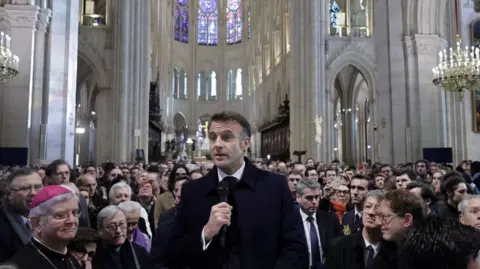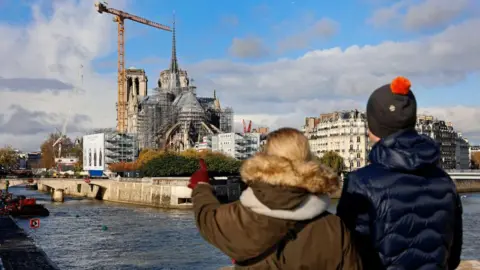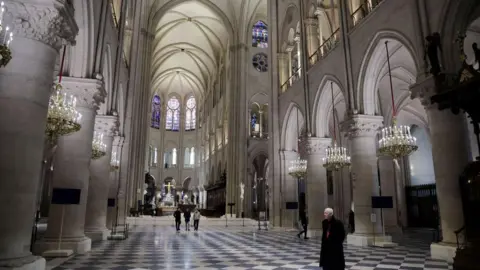A united Macron wants a boost in the reopening

 Reuters
ReutersFrail President Emmanuel Macron hopes to regain political life from the reopening of Notre Dame on Saturday.
Joined by US President-elect Donald Trump, Prince William and other international figures, he will seek to present the restored cathedral as a symbol of France’s inner sources of creative energy.
In a speech to mark the occasion, he will encourage the world to see beyond the current national crisis and praise the determination, organization and hard graft that saved one of France’s most famous buildings in just five years.
The much-anticipated event comes as France enters a period of uncertainty caused by the fall of Prime Minister Michel Barnier’s government on Wednesday. A replacement has not yet been named.
Five and a half years after the devastating fire, Macron had planned to make the opening of the cathedral a hopeful culmination of 2024 – a year also marked by the Paris Olympic Games.
But although he wants to take advantage of the undoubted success of this project, the contrast is unavoidable between the depressed state of the country as a whole, and the growing success of repairing this magnificent Gothic church.
 Getty Images
Getty ImagesThis event marks the time when the Catholic church takes over the church, before the first mass to be celebrated on Sunday.
Archbishop Laurent Ulrich will knock on the front porch using a staff made from one of the salvaged roof planks. Answered by the choir that will be inside, he will enter the church and sing the song “to praise God”.
Macron originally intended to make the address inside the cathedral, but was advised that this would violate France’s strict laws on religion.
As part of the deal, he visited the cathedral eight days ago to thank hundreds of craftsmen and women – a televised tour that allowed the world to preview the stunningly renovated interior.
The evening religious ceremony will be followed by a concert featuring Chinese pianist Lang Lang and Canadian singer Garou.
Sunday’s mass – which the president will attend – will be conducted by Archbishop Ulrich in front of 170 French bishops and priests from 106 parishes in Paris. The first public mass is on Sunday evening, but reservations are required – as it is for everyone scheduled for next week.
 Getty Images
Getty ImagesAnother dignitary who will not be attending is Pope Francis, although he has sent a message to be read on Saturday.
The Pope’s relationship with France is more than friendly. He is reportedly angered by France’s immigration policies, as well as Macron’s decision to enshrine the right to abortion in the constitution.
In the French press, it is said that the Pope is more interested in the small and growing Christian communities of the southern hemisphere than the medieval churches in Europe.
The fire of 15 April 2019 destroyed the medieval timbers, the spire and three parts of the stone vaulting. A donor appeal raised €850m ($897m; £704m), and 2,000 masons, carpenters, art restorers, engineers and architects worked on the project.
“When I looked inside the day after the fire, I knew everything would be fine. The damage was not as bad as I had feared,” said cathedral architect Philippe Villeneuve, who disputes the widespread theory that Notre-Dame is close to total collapse.
“Apart from installing the roof and the spire, the main job was to remove the dirt. Everything was covered in lead oxide powder. But that meant we could restore and clean – which explains why the cathedral looks so beautiful today.”
Before the fire, the cathedral was already considered to be in very poor condition, and scaffolding was in place to restore the spire and other exterior parts damaged by corrosion.
About 12 million people a year used to visit the cathedral, a number that is now expected to increase. A new route around the building has been designed to cope with the 100 visitors per minute expected during the peak tourist season.
Source link





